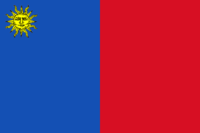Metropolitan Region of Niyi: Difference between revisions
No edit summary |
No edit summary |
||
| (4 intermediate revisions by the same user not shown) | |||
| Line 1: | Line 1: | ||
{{Template:Sanama Article}} | {{Template:Sanama Article}} | ||
{{Template: | {{Template:Subdivisions of Sanama | ||
| | | subdivision = Metropolitan Region of Niyi | ||
| type = metro | |||
| | | local_name = | ||
| | |||
| image_flag = niyi_flag.png | | image_flag = niyi_flag.png | ||
| province_map = niyi_overview.png | | province_map = niyi_overview.png | ||
| capital = [[Niyi]] | | capital = [[Niyi]] | ||
| largecity = [[North Nee City]], [[Brigham]], [[Sanestira]] | | largecity = [[North Nee City]], [[Brigham]], [[Sanestira]] | ||
| population = | | population = 15,754,606 (1680) | ||
| density = 2, | | density = 2,287.59 | ||
| rankpop = 1 | | rankpop = 1 | ||
| area = 6,887 | | area = 6,887 | ||
| rankarea = 8 | | rankarea = 8 | ||
| govex = Mayor | | govex = Mayor | ||
| govleg = Senate ( | | govleg = Senate (101) | ||
| | | llusan = TBA | ||
| language = [[Sanaman language|Sanaman]], [[Istvanistani language|Istvanistani]], [[Cisamarrese language|Cisamarrese]], [[Babkhi language|Babkhi]], [[Red Laqi language|Laqi]] | |||
| religion = [[Somanes]], [[Cedrism]], [[Nazarene|Nazarenism]], others, irreligious | | religion = [[Somanes]], [[Cedrism]], [[Nazarene|Nazarenism]], others, irreligious | ||
| code = NYI | | code = NYI | ||
}} | }} | ||
The ''' | The '''Metropolitan Region of Niyi''' is a region in southern [[Sanama]]. The region has a population of fourteen million people and an area of 7,000 km<sup>2</sup>, making it the most populated and eighth largest region. The region was formed in 1687 with the passage of the new national constitution and is largely coterminous with the previous Niyi province. The region is entirely dominated by the vast [[Niyi]] metropolitan area, which is the largest in the country, containing about a sixth of the entire population. Niyi is also the industrial center of the country since Shirerithian times, with an extensive highway system and a growing railway network. The city of Niyi served as the capital from independence in 1671 until the capital was moved to [[Sanama City]] in 1679. The region is bordered to the west by [[Western Sanilla]] and to the east by [[Central Sanilla]]. It is one of only two landlocked provinces. The province enjoys a subtropical climate with distinct dry and rainy periods. | ||
{{Template:Sanama nav}} | {{Template:Sanama nav}} | ||
[[Category:Provinces of Sanama]] | [[Category:Provinces of Sanama]] | ||
Latest revision as of 19:19, 14 January 2021
| Metropolitan Region of Niyi | |
| – Metropolitan region – | |
| '
| |
|
[[Image:|border|300px]] | |
| Capital | Niyi |
| Largest cities | North Nee City, Brigham, Sanestira |
|
| |
| Population | |
|
15,754,606 (1680) |
|
2,287.59 per km2 |
|
1 of 21 |
|
| |
| Area | |
|
6,887 km2 |
|
8 of 21 |
|
| |
| Government | |
|
Mayor |
|
Senate (101) |
|
| |
| National representation | |
| TBA MLs | |
|
| |
| Official language(s) | {{{official_language}}} |
| Other language(s) | Sanaman, Istvanistani, Cisamarrese, Babkhi, Laqi |
| Local religion | Somanes, Cedrism, Nazarenism, others, irreligious |
| Subdivision code | NYI |
The Metropolitan Region of Niyi is a region in southern Sanama. The region has a population of fourteen million people and an area of 7,000 km2, making it the most populated and eighth largest region. The region was formed in 1687 with the passage of the new national constitution and is largely coterminous with the previous Niyi province. The region is entirely dominated by the vast Niyi metropolitan area, which is the largest in the country, containing about a sixth of the entire population. Niyi is also the industrial center of the country since Shirerithian times, with an extensive highway system and a growing railway network. The city of Niyi served as the capital from independence in 1671 until the capital was moved to Sanama City in 1679. The region is bordered to the west by Western Sanilla and to the east by Central Sanilla. It is one of only two landlocked provinces. The province enjoys a subtropical climate with distinct dry and rainy periods.
| |||||||||||||||||||||||

